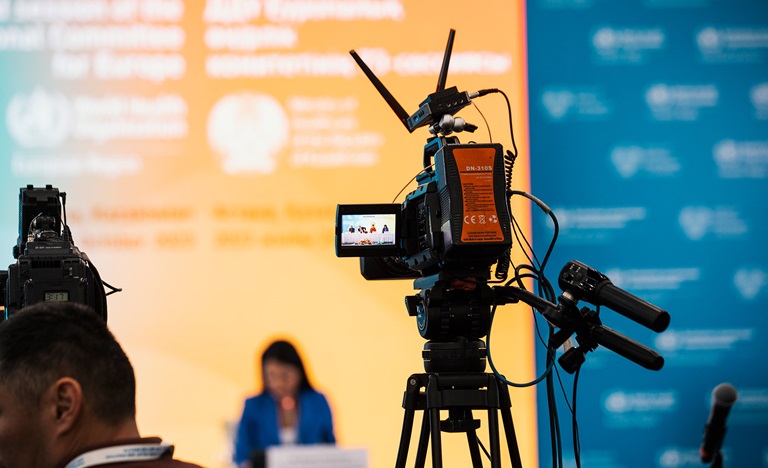
Newsroom
WHO / Uka Borregaard
©
Credits
Media Contacts
![]()
WHO/Europe Press Office
Email: eupress@who.int
Latest news
All →30 seconds to cure cervical cancer: new technology opens door to rapid treatment in Uzbekistan
Nov 9, 2021, 23:59 PM
Treating cervical cancer in future may take just 30 seconds thanks to a futuristic-looking device. The technology, recently recommended by WHO, was introduced in Uzbekistan at a WHO training course preparing the country’s health professionals to use the new equipment in outpatient clinics.
Treating cervical cancer in future may take just 30 seconds thanks to a futuristic-looking device. The technology, recently recommended by WHO, was introduced in Uzbekistan at a WHO training course preparing the country’s health professionals to use the new equipment in outpatient clinics.
For those who need treatment of cervical precancerous lesions, the new therapy will be available in 2 of Uzbekistan’s regions, where 56 000 women are participating in the country’s first human papillomavirus (HPV)-based cervical cancer screening pilot project.
In the WHO European Region, 30 000 women die from cervical cancer every year. Virtually all cervical cancer cases (99%) are caused by genital infection with oncogenic types of HPV.
The good news is that vaccines can prevent HPV infection and related new cancer cases. In addition, new testing techniques and equipment can detect and treat cervical precancers with a high level of effectiveness.
Fighting cancer with heat
The WHO training in Uzbekistan was focused on the new technology of thermal ablation, first recommended for use by WHO in 2019. It helps in the prevention of cervical cancer, with early detection and treatment of cervical precancer by a gynaecologist – all during the same health check.
“The technology is quite simple. There is a medical tool that resembles a pistol, and it uses heat beams (around 100˚C) to eliminate precancer cervical lesions. The whole process takes just 30 seconds and only requires local anaesthesia. The tool is easy to use, and with sufficient experience it can be operated not only by doctors, but also by nurses, in very basic clinical settings, in any region of the country,” said Dr Xavier Carcopino, Chair of the Education Committee of European Federation for Colposcopy. Dr Carcopino was invited to lead the WHO training by the French embassy in Uzbekistan, which also brought the first 4 thermal ablation tools into the country, in close collaboration with Uzbekistan’s Ministry of Health.
During the practical sessions, with the help of Dr Carcopino, the participants were able to treat real patients – the first 4 Uzbek women to ever get the treatment.
Three new cancer treatment tools will be available in the clinics of Karakalpakstan, and 1 in the city of Chirchik. Women living there will be able to take part in the cervical cancer prevention programme based on the latest WHO recommendations.
Detecting the disease: a primary challenge
The course highlighted an important issue that Uzbekistan’s health professionals face today. To use the “heat pistol”, they need to better diagnose precancerous lesions in the cervix at an early stage. According to the participating doctors, they feel that lack of experience in this field is their primary challenge.
“The course was really helpful, it will change the way I usually work. My treatment decisions will become better,” noted one of the health professionals who provided feedback after the training. “I only wish the course could be longer with more practical sessions.”
Very emotional experience
Uzbekistan is the first central Asian country to get the new tools and relevant training in line with the joint United Nations Development Programme/United Nations Population Fund programme “Building the Resilience of Local Communities Against Health, Environmental and Economic Insecurities in the Aral Sea Region” supported by the Government of Japan. WHO/Europe offers technical guidance to the programme in the field of cervical cancer prevention.
Introducing the new technique, which can be undertaken at primary health care level, will allow Uzbek women in remote areas, who would not have immediate access to specialist care, to receive quick and effective treatment, which can be life-saving.
“When we first came to meet health professionals from Uzbekistan’s regions and told them about the programme, it was really emotional. Some of them were telling us how amazing it is to realize that there are organizations who care for women’s health and help clinics to treat them. One of the doctors was even moved to tears,” says Vitaly Smelov, Technical Officer at WHO/Europe.
With a proper vaccination, screening and treatment system, cervical cancer can be eliminated as a life-threatening disease. Uzbekistan and all countries of the WHO European Region have a chance to make this happen in line with the WHO European Programme of Work 2020–2025 – “United Action for Better Health in Europe”.




